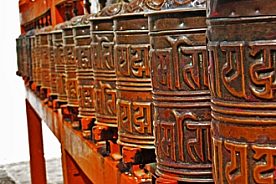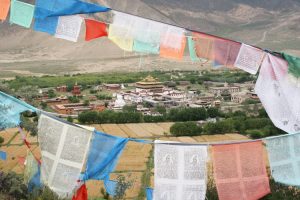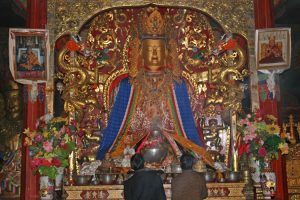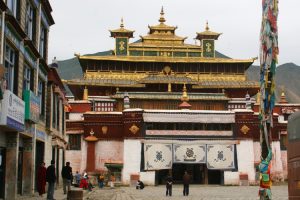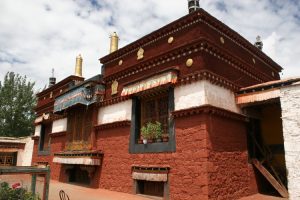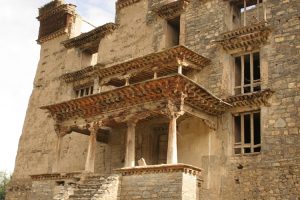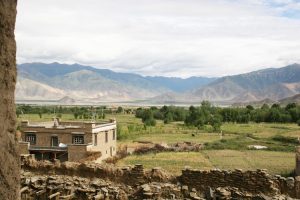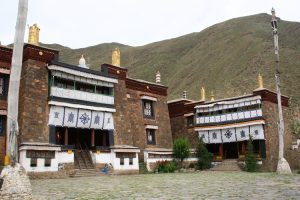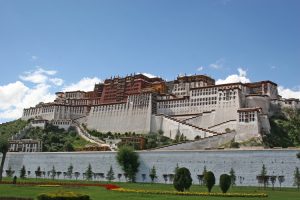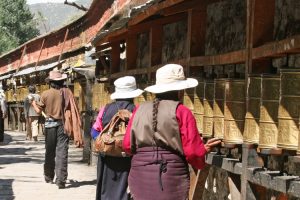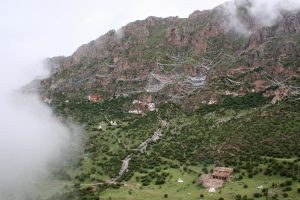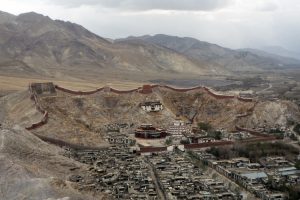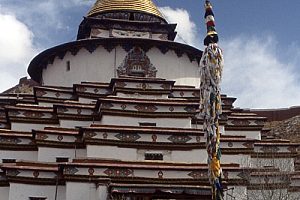An in-depth exploration of the most important religious and cultural sites in this fascinating Himalayan land.
Highlights
- Enjoy a well-paced itinerary with ample time for good acclimatisation
- Attend a Tibetan festival
- See all the major sights of Lhasa together with Shigatse, Gyantse and Sakya
- Stay in comfortable accommodation throughout
This exciting cultural tour to Tibet offers an amazing experience, both for the Tibetan scenery you will encounter and for the Tibetan Buddhist culture. It gives you the opportunity to visit some of Tibet’s most important historical, religious and cultural sites and to travel through the awesome landscapes of the high Tibetan plateau.
You will visit all the most significant sights such as the Potala Palace and Tashilumpo monastery, but also places that many tourists do not usually see, such as the hermit retreat at Drak Yerpa and remote Ralung Gompa, with the chance to also visit an authentic festival. When visiting the ‘Valley of Kings’ you will not only visit the tombs, but also the iconic castle of Yumbulakhang, with a visit to the nearby magnificent Samye monastery. The latter is a fabulous place and in many senses the hub of Buddhism in Tibet. After time in Lhasa we travel west and use the quicker ‘northern’ route to reach Shigatse and then the slower ‘southern’ route back past the spectacular lake of Yamdrok Tso to provide variety.
Tibet occupies the high arid plateau lying immediately north of the Greater Himalaya. It is a vast territory nearly 1,200 miles (2,000km) long and 600 miles (1,000km) wide, most of which lies more than 4,267m/14,000ft above sea level. Behind the high Himalayan barrier, there is little precipitation and much of Tibet is defined as mountain desert. The complete encirclement of Tibet by inhospitable mountains has assisted its centuries-old policy of isolationism. Its hardy people were once ruled by a feudal theocracy based on Tibetan Buddhism. Tibet remained little changed until the mid-20th century – although it was so isolated and considered rather backward it was still a land of magic and mystery.
Private Departures
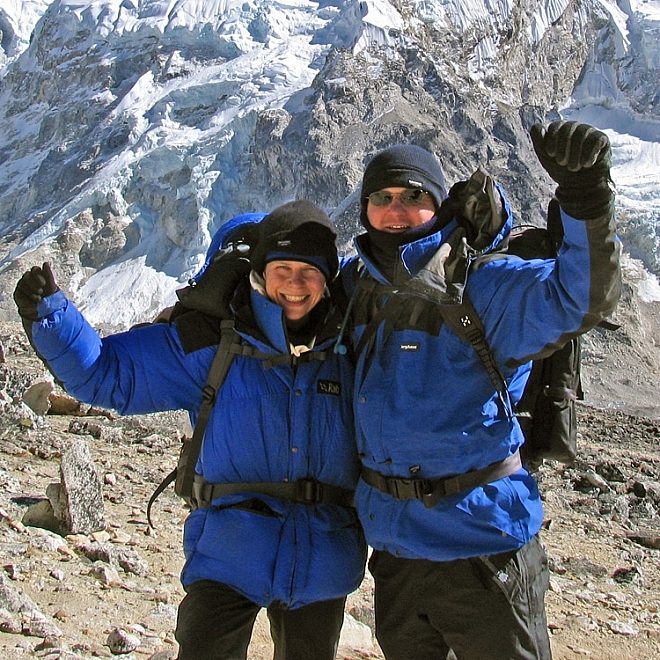
Definitive Cultural Tour of Tibet - Private Departures
If you would prefer to travel just with your partner, friends or family, we can arrange a private departure of this holiday. You follow the same itinerary, but travel on dates that suit you. Alternatively we can include elements of this holiday in a bespoke Tailor Made itinerary. Contact our friendly team for details and prices, and to make a booking.
At a glance
Duration: 15 days from the UK
Max. Altitude: 5,044m/16,549ft, Karo La, Day 13
Private Departures Available
Guaranteed to run for a minimum of 4 clients
Maximum group size: 12
Accommodation types: Hotels
Festival:
The June departure attends the Saga Dawa festival
Meal arrangements: 12 breakfasts, 12 lunches and 10 dinners included as per the itinerary.
Itinerary overview
| Day | Activity |
|---|---|
| 1-3 | (This itinerary is for our May departure. Detailed Itineraries for other departures can be downloaded below). Fly to Chengdu. Visit to Giant Panda Breeding Centre. |
| 4 | Fly to Gonggar, Tibet. Drive to Tsedang. |
| 5 | Sightseeing around Tsedang. Drive to Lhasa. |
| 6-7 | Sightseeing in Lhasa - Potala Palace, Drepung Monastery, Sera Monastery, Jokhang and Barkhor. |
| 8 | Visit Ganden Monastery with kora around the monastery. Visit Drak Yerpa. |
| 9 | Saga Dawa celebrations in Lhasa. |
| 10-11 | Drive to Shigatse Sightseeing and visit to Tashilumpo. Excursion to Sakya Monastery. |
| 12 | Sightseeing in Shigatse. Drive to Gyantse. Sightseeing. |
| 13 | Drive to Lhasa via Ralung Gompa and Yamdrok Tso. |
| 14-15 | Fly to Chengdu. Sightseeing tour. Fly to London. |
Holiday Itinerary
Day 1 - Fly London to Chengdu
Fly overnight from London to Chengdu in China.

Day 2 - Arrive Chengdu. Group transfer to hotel.
On arrival in Chengdu you will be met and transferred to your hotel.

Day 3 - In Chengdu. Visit to Giant Panda Breeding Centre.
In the morning you will have a half day visit to Chengdu's famous Giant Panda Breeding Centre where scientists are running a very successful Giant Panda breeding programme. As well as the adult Giant Pandas you will probably see some charming baby pandas, and in the trees around the site you may also see some red pandas.
You will have lunch as a group before having the afternoon free to relax, do some sightseeing or to explore the Tibetan quarter around your hotel.

Day 4 - Fly to Gonggar, Tibet - 1½ hour flight. Drive to Tsedang - 2 hour drive.
Transfer to the airport for the flight to Gonggar in Tibet. At Gonggar (the airport for Lhasa) you will meet your Tibetan guide and your driver. You then drive east alongside the mighty Tsangpo River to Tsedang, 3,550m/11,647ft. Tsedang, the capital of Shannan prefecture and the second largest city in Tibet after Lhasa, has some Tibetan buildings but as in so much of Tibet, Chinese influence is now predominant. But Tsedang has an important place in the history of Tibet. It was here, on the nearby hill called Gongpo Ri that, according to legend, the Tibetan race originated, from the union of a monkey and an ogress. Tsetang was said to have been their playground.
There might be time this afternoon for a little exploration - Tsedang has a Tibetan quarter with traditional houses and several monasteries of interest - but it is probably best to rest and take it easy to help acclimatise to the altitude. In the main street outside the Tsedang Hotel there are lots of restaurants serving good food - so in the evening you might want to try locally caught fish served with lots of chillies or a Chinese hotpot.

Day 5 - Sightseeing around Tsedang. Drive to Lhasa - 3-4 hour drive.
The area around Tsedang is thought of as the cradle of Tibetan civilisation and today you will visit some of the principal sights. In the nearby Yarlung Valley, a short half hour drive from Tsedang, is the fortress/chapel of Yumbulakang, a distinctive tapering structure perched on a crag. Yumbulakhang is said to be the oldest building in Tibet and to have been built for the legendary King Nyentri Tsenpo. Its origins may date back more than 2,000 years. The temple is currently closed so you will not be able to go inside but the exterior is very photogenic. If you climb the ridge above Yumbulakhang you will get good views of the fortress, the Yarlung Valley and the mountains to the south. The first cultivation in Tibet is thought to have started in this valley. It was also from Yarlung that early Tibetan kings unified Tibet in the 7th century and in nearby Chongye are found the burial mounds of these earliest kings. One of the larger mounds, topped by a monastery, is that of King Songsten Gampo who was the first royal patron of Buddhism in Tibet and in whose reign building on the Jokhang Temple was started.
Trandruck Monastery, also situated near Tsedang, is one of the earliest Buddhist monasteries in Tibet, dating to about the same time as the Jokhang in Lahsa and you should have time to visit it on the way to Yarlung.
After lunch you will visit Samye Monastery. Founded 1,200 years ago it was the first monastery in Tibet with monks. It is most closely associated with the Nyingmapa order of Buddhism, one of the earliest orders of Buddhism, and is one of the most important and spectacular monasteries in Tibet.
In the late afternoon you drive to Lhasa. You travel alongside the Brahmaputra and then by a tunnel through the mountain and continue to Lhasa alongside the Kyichu River. Today, Lhasa looks a very modern Chinese city but your first view of the Potala Palace will still take your breath away. Your hotel is in the central Tibetan quarter and is within walking distance of the Jokhang Temple and the Barkhor Market.

Day 6 - Sightseeing in Lhasa - Potala Palace and Drepung Monastery.
Please note that the schedule for the next few days may be adjusted depending on events and ticket availability for the Potala Palace. Bookings can only be made with your passports once you arrive in Lhasa, and it can sometimes be pretty busy.
The plan is to visit the Potala today. Luckily the Potala remained largely undamaged throughout the years of the Cultural Revolution. Songsten Gampo was the first Tibetan ruler to establish a palace on this outcrop, the 'Red Hill', but construction of the grand palace that you see today began in 1645 during the reign of the Fifth Dalai Lama. The palace is named after Mount Potala, a sacred mountain in South India, and has served as the home of successive Dalai Lamas and their monastic staff. You will start your tour by climbing up the steps at the south side of the building. Take your time doing so, there is even an oxygen station half way up for those who are struggling with the altitude! You then work your way up through successive storeys and through a maze of rooms - through the living quarters of the Dalai Lama and through numerous highly decorated chapels and colourful assembly halls. Walls are decorated with intricate murals and hung with painted thangkas. One of the most awesome rooms is the Chapel of the Dalai Lamas' Tombs, which contains the massive golden stupa of the Fifth Dalai Lama and smaller stupas containing the relics of other Dalai Lamas. When you have completed your tour you will come out at the roof level where the views are stunning, and you will walk down on the northern side, where you will join the Kora path, and as there will be many Tibetan pilgrims making their Kora (circuit) right around the building, you may like to do the same. Please note that although photography is not permitted inside the Potala, you may take photos on the approach up the steps, once you emerge at the rear.
In the afternoon you will visit Drepung Monastery, just a few miles out of Lhasa. Drepung, Sera and Ganden Monasteries make up the three great Gelukpa Monasteries of Tibet with Drepung possibly the most important of all. The name Drepung means 'piles of rice' and comes from its appearance when seen from afar. Drepung was founded in the 15th century and was long a centre of Buddhist study with as many as 10,000 monks. Even today it is a centre of resistance to Chinese authority and was closed down by the authorities for several years at the beginning of the century. The 'debates' held by Drepung's monks are famous.

Day 7 - Sightseeing in Lhasa - Sera Monastery, Jokhang and Barkhor.
This morning you will drive 40 minutes to Sera Monastery, one of the three great Gelukpa monasteries near Lhasa. This monastery dates back to the 15th century and was formerly a monastic township housing over 5,000 monks. Although many of the outlying buildings have been destroyed the principal buildings were left relatively intact and nowadays the monastic population is again over 300 monks. Sera is particularly famous for its great monastic debates and monks can still be seen debating in the debating courtyard. More prosaic but equally fascinating are the large monastic kitchens where monks prepare industrial quantities of food in huge copper cauldrons. It is quite a sight to see Tibetan tea being blended with a mixer the size of a road drill!
Later you will visit the Jokhang Temple. This is the most sacred temple in Tibet and the centre of the Tibetan city. Pilgrims from all over Tibet flock to visit it. You will see them circling the Barkhor turning their prayer wheels or making full-length prostrations around the temple. To visit the Jokhang you will join these pilgrims as they shuffle round inside, making their offerings and feeding the thousands of flickering butter lamps. The temple was initially established in the 7th century by King Songtsen Gampo. It takes its name from the sacred image of the Buddha, the Jowo Shakyamuni, the most highly revered image in Tibet, a statue which was brought to Tibet by Songtsen Gampo's Chinese wife and which is now housed in one of the chapels of the Jokhang. The Jokhang itself was however originally designed by Nepalese craftsmen brought to Tibet by Songtsen Gampo's second wife who was from Nepal. Since that time the temple was further enlarged during the reign of the Fifth Dalai Lama. It is worth visiting the roof of the Jokhang for wonderful views of the city and surrounding hills.
The nearby Barkhor market is full of vendors selling all manner of wares; stirrups for dashing nomad horsemen, tacky souvenirs for Chinese tourists and all sorts of other ephemera. Shops in the nearby streets display huge slabs of butter which pilgrims purchase to feed the butter lamps in the Jokhang temple. The characteristic rather cheesy smell of such temples is from these butter lamps.

Day 8 - Visit Ganden Monastery with a kora around the monastery. Visit Drak Yerpa.
Today you visit Ganden Monastery, one of the earliest and largest Buddhist monasteries in Tibet. Ganden is located on the southern bank of Lhasa River about 47 kilometres (29 miles) from Lhasa City. Along with Sera and Drepung, Ganden is one of three great Gelukpa university monasteries of Tibet. It was the original monastery of the Geluk order, founded by Tsongkhapa himself, and is traditionally considered to be the seat of Geluk administrative and political power. Nowadays, the monastery houses 400 monks. You will have time to make the 3km kora of the monastery along with other pilgrims and visitors - remember these are always performed in a clockwise direction!
On the way back from Ganden you will visit Drak Yerpa the site of an important historic hermitage and one of Tibet's principal cave retreats, with links to many important figures in Tibetan Buddhism, a mystical place.

Day 9 - Saga Dawa celebrations in Lhasa.
The day of the Saga Dawa Festival, which falls in the fourth Tibetan month, is considered to be the holiest day of the year in Tibet and is one of the most important festivals. Three memorable occasions coincide on this auspicious day: Buddha's birth, Buddha's death and Buddha's enlightenment. In Lhasa although there are no fixed celebrations visiting pilgrims will join in circumambulation of various sites in the city, principally round the Potala Palace and round the Barkhor and there may also be further ceremonies at monasteries around Lhasa. After joining a kora and participating in a ceremony many Tibetans will spend the late afternoon picnicking at spots such as the "Dzongyab Lukhang" near the Potala Palace or elsewhere. You will be able to join them for a kora round the Potala and your guide may suggest additional ways to join any festivities.
If time after the festivities you may visit the Norbulinka, the Dalai Lama's former summer palace and gardens.

Day 10 - Drive to Shigatse by northern route - 4-5 hrs drive. Sightseeing in Shigatse and visit Tashilumpo.
Today you will drive via the more direct northern route to Shigatse which is Tibet's second largest city and the capital of Tsang province. It is a busy, modern city and has long been an important trading centre. Formerly Shigatse was dominated by a massive castle built on a hill above the old town which was destroyed during the cultural revolution. This castle was the seat of the kings of Tsang in the 16th and 17th centuries. The castle of Shigatse has been restored and is now likened to a 'little Potala Palace'.
The most important remaining Tibetan institution in Shigatse is the Tashilumpo Monastery, one of the six largest Gelukpa monasteries in Tibet. This monastery was founded in 1447 and housed at its peak over 4,500 monks. This impressive monastery contains the world's largest gilded copper image, a massive seated image of Maitreya (the future Buddha - embodying loving kindness and benevolence). This image is 26 metres high and is very imposing. Like the Jokhang in Lhasa, Tashilunpo Monastery is a major focus of pilgrimage for Tibetan pilgrims. Shigatse is the seat of the Panchen Lama who since the 18th century was a rival source of spiritual power to the Dalai Lama. The last Panchen Lama, the Tenth, died in 1989 and there is still some dispute over his successor and mystery over his whereabouts.
When you are walking around the monastery watch out for the packs of dogs. They are fed by the monks because dogs are said to be the souls of reincarnated monks. You can also walk up to the castle and it is worth visiting Shigatse's interesting local Tibetan market. Look out here especially for the rather gruesome whole dried sheep.

Day 11 - Day excursion to Sakya to visit Sakya Monastery. Return to Shigatse.
Today you will make an excursion to Sakya, 130kms from Shigatse. Nowadays the roads are much improved so this is quite a fast journey leaving you with plenty of time to explore the famous and important Sakya Monastery. Sakya is quite a small town but has many modern, ugly, concrete buildings which contrast very oddly with the imposing monolithic windowless grey walls of the monastery. You will visit the monastery and have lunch in Sakya.
Sakya Monastery is one of the largest and most important monasteries in Tibet and much of South Sakya survived the destruction of the Chinese Cultural Revolution. The massive walls of the monastery are unusual - they are painted grey, with white and red vertical stripes. Protruding rain spouts are carved as gargoyles of mythological beings. The temples within these walls are also huge and awe-inspiring. On a similar large scale, an illuminated manuscript (The Prajnaparamitasutra), which may be the biggest book in the world, is kept in the Great Library of the monastery. Sakya Monastery, from which the Sakya order of Buddhism is named, was founded in 1073 and unusually the position of head abbot is hereditary not by reincarnation. Sakya has a very important place in the history of Tibet. It was an abbot of Sakya, known as Sakya Pandita, who presided over the beginning of Sakya's most glorious years. Revered as one of the greatest lamas of his generation Sakya Pandita travelled to Mongolia and met the Mongolian emperor Godan Khan in 1247 and came to be recognised as an important ally of the Mongols. Later in 1251 Kublai Khan heaped honours on Pakpa, Sakya Pandita's successor, and made him the ruler of Tibet under Mongolian overlordship, the first effective ruler of Tibet since the Yarlung dynasty. During this time Sakya was a powerful place and was 'de facto' capital of Tibet. Tibet was ruled from here for a hundred years and during that time many temples of the Sakya sect were founded throughout Tibet. After you have visited the main south monastery it is possible to walk right round the outside of the monastery or to explore the ruins of Northern Sakya, where esoteric tantric practices were formerly taught. Some rebuilding and restoration has taken place there in recent years.
You will return to Shigatse to overnight.

Day 12 - Sightseeing in Shigatse. Drive to Gyantse - 1½ hour drive. Sightseeing.
In the morning you will have time to see any of the sights of Shigatse you have not yet seen. Then, you will make the short drive to Gyantse. This drive is nowadays all on hardtop road and takes 1-2 hours only. You will then have the rest of the day to explore Gyantse.
Although Gyantse has been affected by development it is still, even today, quite small and is one of the most traditionally Tibetan of towns, probably the most Tibetan of all the towns you visit on this trip. It has somewhat of a 'wild west' air. Gyantse is situated at the junction of trade routes from Lhasa and the east, Shigatse to the west and India to the south and came to importance as the centre for Tibet's wool trade.
A great castle on the hilltop overlooks the entire area. In 1904 this castle, which guarded the route to Lhasa, was the scene of a military siege during the British Younghusband Expedition. In the castle a museum tells the story from the Tibetan/Chinese point of view and at the summit you will find a small monument to the Tibetans who died during the siege.
The monastic complex of Gyantse Pelkhor Chode is set against the hill and the whole area is surrounded by a high wall which runs along the ridge of the hill behind and then along in front of the religious buildings sealing them off from the rest of the town. Here you will see some of the most superb architecture and art in the whole of Tibet. The finest buildings still remaining from the former glory of this monastery are the great Kumbum Stupa and the temple of Tsuklakhang. The marvellous Kumbum Stupa (The stupa of 100,000 deities) is a great octagonal nine-storeyed stupa and is one of the most magnificent buildings in Tibet. It was built and decorated in the 15th century and its architect was from Nepal. You may climb up through the many storeys to visit its dozens of small chapels. The Tsuklakhang Temple is the central monastic building of the complex. (Sometimes this building is also called Pelkhor Chode or this term can refer to the whole monastic complex). This temple was founded in the 15th century and houses many wonderful painted murals and carved images. Be sure to visit the Samvara Chapel and the Chapel of Sixteen Arhats. The wonderfully executed statues in these chapels look like carved wood but are believed to be made of clay. Upstairs is a chapel with a series of awesome painted mandalas.

Day 13 - Drive to Lhasa by southern route, via Ralung Gompa and Yamdrok Tso - 6-7 hour drive.
The road from Gyantse to Lhasa by the southern route has recently been upgraded so what used to be an arduous all day journey, although still long, should nowadays be less difficult. From Gyantse the road continues along the valley floor and then climbs slowly up to the Karo La, 5,044m/16,549ft. However, before climbing the pass you will make a detour south to visit Ralung Gompa. This gompa is rarely visited but is of huge significance and is one of the most sacred places in Tibet. This is the monastery that was the origin of the Drukpa sect of Buddhism. It was here that the first ruler of Bhutan was born and brought up and fled in 1616 after a vision told him to create a kingdom over the mountains to the south. It is an extraordinarily beautiful setting . The original monastery was destroyed by the Red Guard but the new temple is of high quality. It sits on its own, miles from anywhere.
After the visit you return to the main road and climb to the Karo La. Just before the pass a huge glacier comes down on the north side of the road. This is a magnificent spot but unfortunately it has been colonised by a group of aggressively pushy souvenir sellers who will offer you a yak to have your photo taken with and other such touristic joys; an unusual experience for Tibet and a great pity because it mars the enjoyment of this wonderful spot. On either side are gigantic peaks including Nazin Kang Sa, 7,252m/23,792ft.
In May 1904 the Karo La was the site of one of the world's highest 'battles' (probably more of a skirmish), between the Tibetans and the British Younghusband Expedition. From the pass the road drops to Yamdrok Tso, a huge lake, said to be in the shape of a scorpion. The road follows the twisting northern bank for hours, before climbing again to the Kamba La, 4,793m/15,724ft. Then you descend the zig-zag road to cross the mighty Yarlung Tsangpo River (this river becomes the Brahmaputra when it enters India). The road then follows the Kyichu River to approach Lhasa. Colourful rock carvings of Buddha are passed as you again enter the outskirts of Lhasa.

Day 14 - Fly to Chengdu. Sightseeing in Chengdu. Group transfer back to airport for flight to London.
After an early breakfast you will drive to Gonggar airport where you will say goodbye to your Tibetan guide and driver and check in for your flight to Chengdu. On arrival in Chengdu you will be met and, after lunch, you will be taken on a half day sightseeing tour. In the late afternoon you will transfer back to the airport to check in for your overnight flight home.

Day 15 - Arrive London
Map
Map Key
-
 Airport
Airport
-
 Point of interest
Point of interest
-
 Mountain Peak
Mountain Peak
-
 Day walk in this area
Day walk in this area
-
 Flights
Flights
-
 Internal Transfers
Internal Transfers
-
 Trek
Trek
Loading...
Hold your place
Not quite ready to book? Why not call us on +44 (0) 1453 844400 to hold a no obligation place while you make up your mind?
Optional supplements
-
Single room
From £405
No Surcharge Guarantee
No surcharges will be applied to your holiday after you book. Prices on this website are updated regularly. The Flight Inclusive holiday price, or Land Only holiday price, will be confirmed to you at the time you make your booking. There will be no surcharges after your booking has been confirmed.
Flight inclusive holidays
The 'flight inclusive' holiday prices shown on this website are based upon our preferred airlines and the best priced economy class fares we are able to secure at the time of publication.
We will be able to advise on fares with alternative airlines, upgrades to Business Class, and the options for flights from regional UK airports, please contact us for more details.
Booking your holiday
-
Deposit
From £400.00
For the majority of our holidays, a deposit payment of £400.00 per person is required to secure your place(s), however a small number of holidays require a higher deposit - please refer to the holiday itinerary for more details. If the holiday departs within 60 days, a deposit of £1,000.00 per person is required.
Book now!
- Book your small group holiday securely online – click the ‘Book’ button next to your chosen departure or visit our How to Book page
- Complete and return a Booking Form available to download here.
- Call us on +44 (0)1453 844400 and one of our travel specialists will talk you through the booking process.
What’s included
- A Tibetan English-speaking leader
- Economy class return air fares from the UK & UK Departure Tax (flight inclusive only)
- Single, timed group airport transfer arranged to coinicide with the timings of the group flights
- All internal flights and hotel/airport transfers
- Good standard hotel accommodation in Chengdu on a twin share basis
- Best available hotels in Tibet on full board
- All road transport by private vehicles
- Fees for Tibet permit
- Sightseeing where specified
- Carbon offsetting with the Ecoan Tree Planting Project (for clients taking our flight inclusive option)
- A free Mountain Kingdoms Water-to-Go bottle
- The opportunity to attend one of our pre trip meets in the Cotswolds
What’s not included
- Travel insurance
- China visa fees
- Dinners in Chengdu
- Optional trips
- Tips
Read holiday reviews by Mountain Kingdoms travellers.
Overall score: 5 (Based on 4 reviews)
A really well thought out itinerary - good choice of monasteries and a stunning drive back to Lhasa on the final day.
The itinerary was excellent. Each day we saw/visited amazing, unique places that made me stop in my tracks. Feel lucky to have been to Tibet, I can't praise it enough. I loved the hotels in Tibet; may not have been 5 star but had character and the staff were excellent.
It was a very enjoyable adventure trip, well planned and full of interest. The way the places we stayed in gradually built up in altitude was very helpful.
Tibet is an amazing place to visit and I would go again.


